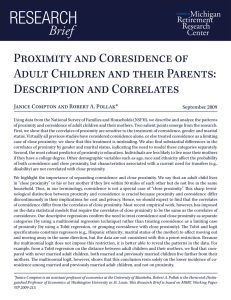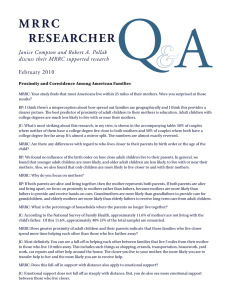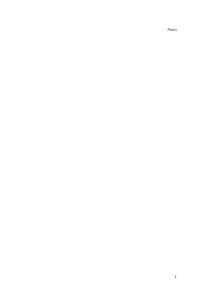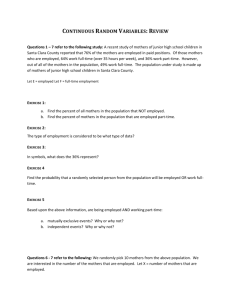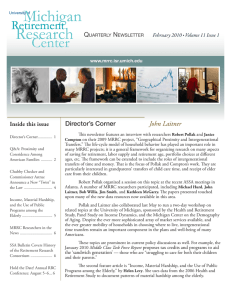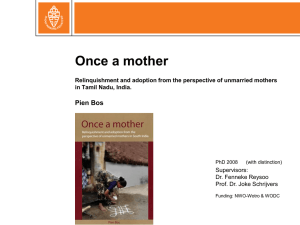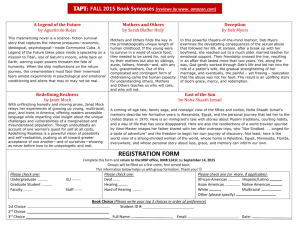ReseaRch Brief GEOGRAPHIC DISPERSION AND THE WELL-BEING OF THE ELDERLY
advertisement
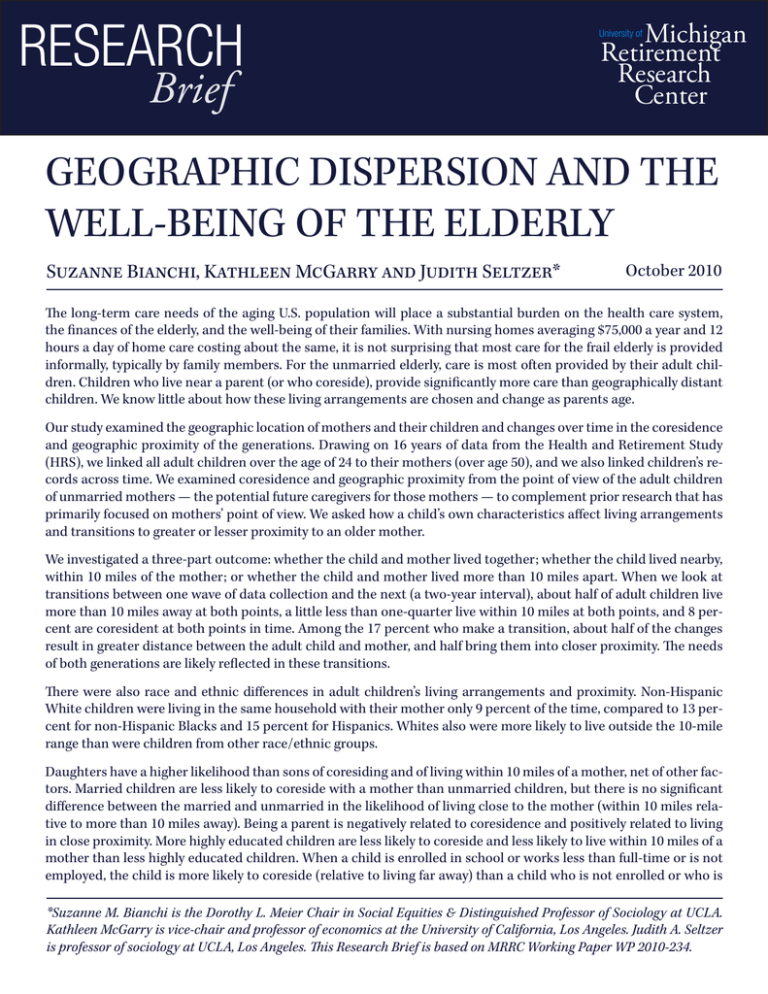
ReseaRch Brief Michigan Retirement Research Center University of GEOGRAPHIC DISPERSION AND THE WELL-BEING OF THE ELDERLY Suzanne Bianchi, Kathleen McGarry and Judith Seltzer* October 2010 The long-term care needs of the aging U.S. population will place a substantial burden on the health care system, the finances of the elderly, and the well-being of their families. With nursing homes averaging $75,000 a year and 12 hours a day of home care costing about the same, it is not surprising that most care for the frail elderly is provided informally, typically by family members. For the unmarried elderly, care is most often provided by their adult children. Children who live near a parent (or who coreside), provide significantly more care than geographically distant children. We know little about how these living arrangements are chosen and change as parents age. Our study examined the geographic location of mothers and their children and changes over time in the coresidence and geographic proximity of the generations. Drawing on 16 years of data from the Health and Retirement Study (HRS), we linked all adult children over the age of 24 to their mothers (over age 50), and we also linked children’s records across time. We examined coresidence and geographic proximity from the point of view of the adult children of unmarried mothers — the potential future caregivers for those mothers — to complement prior research that has primarily focused on mothers’ point of view. We asked how a child’s own characteristics affect living arrangements and transitions to greater or lesser proximity to an older mother. We investigated a three-part outcome: whether the child and mother lived together; whether the child lived nearby, within 10 miles of the mother; or whether the child and mother lived more than 10 miles apart. When we look at transitions between one wave of data collection and the next (a two-year interval), about half of adult children live more than 10 miles away at both points, a little less than one-quarter live within 10 miles at both points, and 8 percent are coresident at both points in time. Among the 17 percent who make a transition, about half of the changes result in greater distance between the adult child and mother, and half bring them into closer proximity. The needs of both generations are likely reflected in these transitions. There were also race and ethnic differences in adult children’s living arrangements and proximity. Non-Hispanic White children were living in the same household with their mother only 9 percent of the time, compared to 13 percent for non-Hispanic Blacks and 15 percent for Hispanics. Whites also were more likely to live outside the 10-mile range than were children from other race/ethnic groups. Daughters have a higher likelihood than sons of coresiding and of living within 10 miles of a mother, net of other factors. Married children are less likely to coreside with a mother than unmarried children, but there is no significant difference between the married and unmarried in the likelihood of living close to the mother (within 10 miles relative to more than 10 miles away). Being a parent is negatively related to coresidence and positively related to living in close proximity. More highly educated children are less likely to coreside and less likely to live within 10 miles of a mother than less highly educated children. When a child is enrolled in school or works less than full-time or is not employed, the child is more likely to coreside (relative to living far away) than a child who is not enrolled or who is *Suzanne M. Bianchi is the Dorothy L. Meier Chair in Social Equities & Distinguished Professor of Sociology at UCLA. Kathleen McGarry is vice-chair and professor of economics at the University of California, Los Angeles. Judith A. Seltzer is professor of sociology at UCLA, Los Angeles. This Research Brief is based on MRRC Working Paper WP 2010-234. employed full-time. Not working is associated with a lower likelihood of living nearby (relative to farther away) compared with being employed full-time. When Do Children and Mothers Transition To Greater Geographic Proximity? In our longitudinal analysis, we found that coresidence and proximity were related to mothers’ health, although not as strongly as we anticipated. When mothers’ health is poor, children are more likely to transition to coresidence than when mothers are in excellent health. Mother’s health is not associated with transitions to coresidence when the child already lives close by. Mother’s age is also associated with movements to coresidence. Compared with mothers ages 50–54, those whose mothers are older are more likely to move to coresidence, although the association does not appear to be linear with increasing age of the mother. Children’s characteristics are associated with transitions as well. Married children are less likely to transition to coresidence than unmarried children, but children who are parents themselves are more likely to move to coresidence. Education does not have a statistically significant association with moves from a distant location to coresidence. Children who are employed only part-time or who are not employed at all are more likely to transition to coresidence than those who are employed full-time. Again, this result provides evidence that many of these coresident arrangements may be for the benefit of the child. Increases in mother’s age, however, are associated with increased coresidence, at least compared to mothers in their early 50s. This research highlights the importance of considering both child and parent characteristics in studies of the potential availability of adult children to provide care. It also illustrates the complexity in determining who is providing care to whom, especially in an era of delayed nestleaving on the part of adult children and increased (healthy) life expectancy on the part of older mothers. We set the stage for further investigation of whether it is the parent’s or the child’s needs that precipitate a geographic move. A better understanding of the complexities of mobility and proximity of adult children and older parents is necessary to estimate the potential (unmet) caregiving need in the coming decade as the Baby Boom generation retires and ages into the years when assistance is most required. University of Michigan Retirement Research Center Institute for Social Research 426 Thompson Street Room 3026 Ann Arbor, MI 48104-2321 Phone: (734) 615-0422 Fax: (734) 615-2180 mrrc@isr.umich.edu www.mrrc.isr.umich.edu The research reported herein was performed pursuant to a grant from the U.S. Social Security administration (SSA) through the Michigan Retirement Research Center (MRRC). The findings and conclusions expressed are solely those of the author(s) and do not represent the views of SSA, any agency of the federal government, or the MRRC. Regents of the University of Michigan: Julia Donovan Darlow, Laurence B. Deitch, Denise Ilitch, Olivia P. Maynard, Andrea Fischer Newman, Andrew C. Richner, S. Martin Taylor, Katherine E. White, Mary Sue Coleman, Ex Officio
